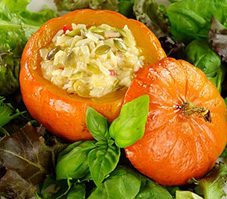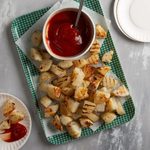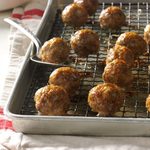Rice-Stuffed Squash
Here’s an attractive and fun way to serve small winter squashes-filled with a mixture of wild and white rice, chestnuts, dried cranberries, and mozzarella cheese.
Number of servings : 4
Prep time: 25 minutes
Cooking time: 45 minutes
Type of meal : | Side Dishes | Side Dishes
Special diet :
Ingredients
1 cup mixed basmati and wild rice
3 cups water
4 small acorn squashes
¾ cup cooked chestnuts (canned or vacuum packed), roughly chopped
½ cup dried cranberries
1 small red onion, finely chopped
2 tablespoons chopped fresh thyme
2 tablespoons chopped parsley
½ cup grated mozzarella cheese
Salt and pepper
Directions
- Put the rice in a saucepan, add the 3 cups water, and bring to a boil. Cover, and simmer very gently until the rice is just tender, about 20 minutes. Drain off any excess water.
- Meanwhile, preheat the oven to 350°F. Using a large, sharp knife, slice off the top quarter (stalk end) of each squash. Set aside these little hats, then scoop out the seeds and fiber from the center of the squashes using a small spoon. Trim the bases to make them level, if necessary. Season the cavity of each squash lightly with salt and pepper, then place them in a large ovenproof dish or roasting pan.
- Mix together the rice, chestnuts, cranberries, onion, thyme, parsley, and mozzarella in a large bowl. Season lightly with salt and pepper.
- Spoon the rice stuffing into the squashes, pressing it down, and mounding it up neatly on top. Replace the reserved "hats" on top. Bake until the flesh of the squash is tender when pierced with a small, sharp knife, about 45 minutes. Serve hot.
Some More Ideas
Use other winter squashes such as small pumpkins instead of acorn squash. The cooking time can vary from 45 to 60 minutes, depending on the type of squash and its size. Replace the mozzarella with other cheeses, such as Gruyère.
Plus Points
- Acorn squash is a winter variety of squash. Winter squashes are allowed to mature into hard, starchy vegetable fruits with very good keeping properties, while varieties such as zucchini are eaten while immature and the skins are still edible. Acorn squash is a good source of beta-carotene, which the body can convert to vitamin A.
- Unlike other nuts, chestnuts are low in fat-other nuts have up to 20 times as much fat. Chestnuts are also a good source of thiamine and potassium, and a valuable source of dietary fiber.
- Both dried and fresh cranberries are a good source of vitamin C. Cranberries also have the reputation of helping to control urinary tract infections such as cystitis.
Nutritional information:




